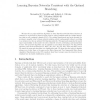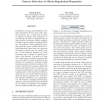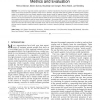352 search results - page 55 / 71 » The Structure of First-Order Causality |
ICMLA
2007
13 years 9 months ago
2007
We introduce a polynomial-time algorithm to learn Bayesian networks whose structure is restricted to nodes with in-degree at most k and to edges consistent with the optimal branch...
UAI
2008
13 years 9 months ago
2008
Identifying co-varying causal elements in very high dimensional feature space with internal structures, e.g., a space with as many as millions of linearly ordered features, as one...
IJCAI
2003
13 years 9 months ago
2003
Conventional methods used for the interpretation of activation data provided by functional neuroimaging techniques provide useful insights on what the networks of cerebral structu...
IS
2011
13 years 2 months ago
2011
—It is common for large and complex organizations to maintain repositories of business process models in order to document and to continuously improve their operations. Given suc...
KDD
1994
ACM
13 years 11 months ago
1994
ACM
We applied TETRAD II, a causal discovery program developed in Carnegie Mellon University's Department of Philosophy, to a database containing information on 204 U.S. colleges...



